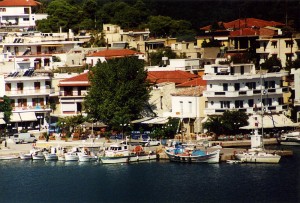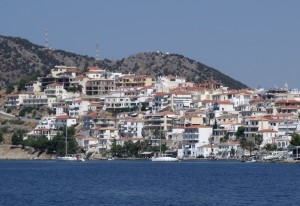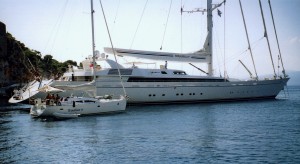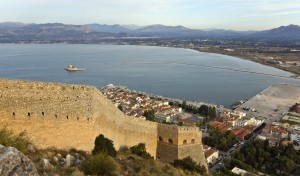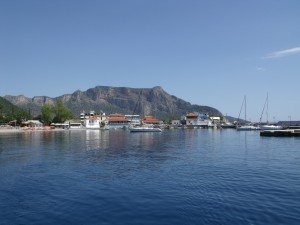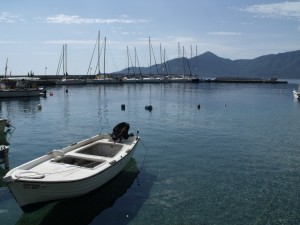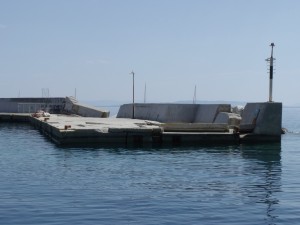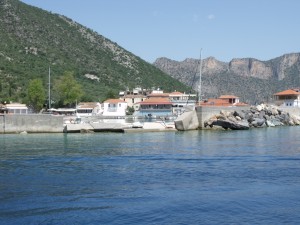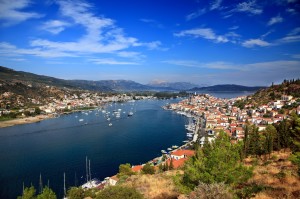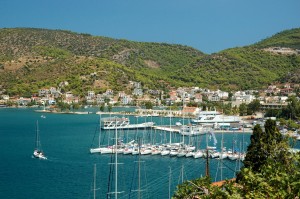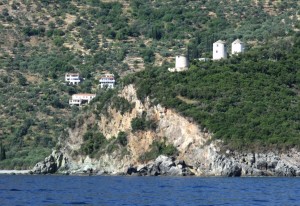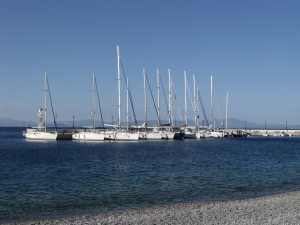- Mooring: Aegina

Aegina: The harbour (centre) and marina (right) entrances, with the red cupola
Getting to Aegina is easy – you can see the ferries and hydrofoils going in and out (beware hydrofoils reversing out of the harbour) and the reddy orange cupola is also very visible. If coming from the south beware the reef that runs across to Angistri. There’s a big gap but you will need to do a bit of navigation.
Head in to the inner harbour, passing the entrance to the marina on the right. The marina is reserved for local craft. There is often a swell just outside the harbour in the afternoons and you may prefer to rig fenders and lines inside the inner harbour – there’s plenty of space to float around. Smile at the small white church on the left quay as you enter – a photographer often lurks there and will appear with large prints for you to purchase once you’ve moored up.
You can moor on the north quay, or for a quieter night (but a longer walk to town) on the opposite side, either on the quay (beware the slip at the east end) or on the pontoons if you can find a gap.
The afternoon winds blow across the harbour and can be gusty so Aegina rewards good boat handling. However, there’s plenty of room if you have a bit of a loss of talent on the way in. Lay your anchor a bit up wind and put out a decent length as the holding is only average.
Continue reading → - Mooring: Astros / Astrous
Coming from the north you won’t see the town until you round the headland. It’s much easier to find from the south though confusingly from a distance it looks like an island. Closer in you will be able to make out the castle and breakwater.
The sea tends to build up as the Argolic Gulf narrows towards the north, so it is not unusual to be bounced around as you near the entrance. It is often best to go in to the harbour before rigging fenders and warps – there’s plenty of room to float around inside.
Mooring is normally stern or bows to on the inside of the breakwater, using the seaward half. There is a kink in the quay about a third of the way along where there’s a large underwater rock against the quay. There are a few smaller rocks at the quay edge further in too, so keep an eye out if coming in stern to.
The seaward end of the quay is sometimes used by trip boats and you may be moved on by the port police if you moor here (they sometimes mark off the area if a boat is expected). This area is best avoided anyway as the swell can work its way round the end.
Astros is prone to strong winds in the late afternoon and evening. On occasions, I have had to re-moor yachts side to as the holding in the harbour is patchy. The winds usually die down later on but you might need to delay dinner for an hour to keep an eye on your yacht.
Continue reading → - Mooring: Athens Kalamaki
The marina is not easy to see from the sea, but as you approach look out for the vast number of masts. Keep clear of the reef about a mile south east of the entrance which extends from Ay Kosmas.
Many of the berths are allocated to the charter companies so unless your company has berths here, you may want to call up the marina (VHF ch 71 or 16) for guidance. Mooring (lazy) lines are laid in the marina so don’t use your anchor unless directed to.
Continue reading → - Mooring: Epidavros
There are in fact two Epidavros’s (or should that be Epidavri) – you want Palaia (old) Epidavros, not Nea (new) Epidavros. To add to the confusion you may also find the name spelt Ephidavros, Ephidvaro, Epidauro or Epidaurus. So make sure you go to the right place.
The bay is not easy to spot from a distance but look out for the scar running along the hillside south of the town from the modernised road. As you get closer, the road can be seen heading down into the town. Head in to the bay between the two marks (the starboard one previously demolished by a drunken skipper). There is a light structure on the end of the jetty, though I don’t recall ever seeing it lit.
First choice for moorings is to go stern to on the quay to the south of the jetty, between the fishing boats on the jetty side and those further south down the quay. A painted area marks the space for yachts.
Note there is a lot of junk on the sea bed just south of the jetty so try to avoid laying your anchor too close to the fishing boats there and if you’ve a choice, take a berth further down the quay.
The other two mooring options are stern to on the end of the jetty or alongside the north side of the jetty. If using the end of the jetty, you’ll need plenty of anchor chain out – it’s deep here.
The north side of the jetty used to be the hydrofoil berth though the town hasn’t had a service for some years now, despite the quay markings being repainted in recent times! Keep close to the quay as you come in as it’s shallow further off, and larger yachts may find insufficient depth at the inner end.
Anchoring enthusiasts can find a spot on the south side of the bay, from where it is only a short paddle ashore.
The bay can experience some uncomfortable swells in the afternoon but these generally die away in the evening. In jellyfish season (the area seems to suffer a plague of these about every three years) the water near the quay is packed with unfortunates that have washed in to the bay, never to depart. I once had and unusual engine failure here when one was sucked in to the water inlet, blocking the cooling system and destroying the impeller. I spend a none too pleasant morning purging the system of bits of impeller and lots of slimy pulped jellyfish! Just my luck – I’ve never heard of anyone else having a similar problem.
Continue reading → - Mooring: Ermioni
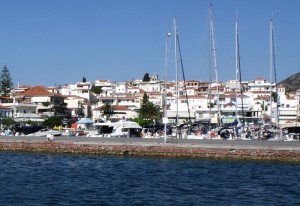
Ermioni: The quay, Limania, with yachts on the west side
Ermioni is hard to miss – just follow the coast west and the tip of the peninsula will appear, often looking initially like an island.
The choice is then whether to moor on the north side or the south, a decision that often depends on the weather, though may also be influenced one way or the other by the large number of bars on the south side. If it’s blowing from the north, go to the south side and vice versa.
On the north side, the better places are stern or bows to on the east side of the main T shaped quay (the first quay you come to), or alongside the inner top side of the T (the top of the T ie the outer side, is used by the hydrofoils).
The west side of the quay is less desireable, firstly because there’s very little room to get a good length of anchor out, secondly because the holding is poor and thirdly because any wind usually funnels down the valley to the north west, which tends to push you back on to the quay. However, as this used to be the only place to moor, you’ll still find a lot of yachts head here, as you can see in the picture above.
On the south side you can you stern to the main length of quay, outside the bars. It’s deep off the quay so you’ll need plenty of chain. Just to the east of this area, there’s a short length of quay where you can go alongside though trawlers sometimes use this. The further west you go along the main quay, the shallower the water near the quay so you may have to hang out a little.
Water is available on both north and south sides though you will have to phone the water man. The port police may ask you for mooring fees but they’re not large and not always collected.
Continue reading → - Mooring: Hydra

Hydra: The Island from the north west. The town is hard to sport until close in.
The harbour can be hard to spot from a distance, especially if travelling along the coast, as it is well recessed in to the coastline. Look out for the many yachts, ferries and other vessels heading in to and out of the port.
Hydrofoils and fast catamarans berth on the quay just inside the harbour entrance on the left as you enter. When leaving, they reverse out of the harbour and turn around outside. So as you approach the harbour watch out for these vessels both ahead of you but also approaching from behind. This tends to be the time when everyone is preoccupied rigging warps and fenders and may are the yachtsmen who have suddenly looked up to see a hydrofoil bearing down on them!
Worry less about the water taxis that dart about – they are well able to dodge around you. Fishing boats are less able to do so, so avoid mowing down the locals! The landing craft type vessel that delivers all the islands supplies has very restricted manoeuvrability so leave it plenty of room. In fact, it’s quite impressive watching it wriggle in and out of its berth, though I did once see it bend the guard rails of a yacht that strayed just a little too close to the reserved space.
Sadly, the greatest hazard you face is other yachts, some of whom career around far too fast and barge in where others are already trying to moor.
Once inside the harbour you have two choices, stern to on the south quay that faces you as you enter, or stern to on the north quay.
On the south quay avoid the south east corner which is reserved for water taxis, or just past the middle where the cargo vessel berths. Both areas are often marked off with cones or posts, and if you ignore them, you will have the rare spectacle of a port policeman actually appearing on the quay! Keep yourself pulled well off the quay when moored as the wash from other traffic can otherwise be a problem.
If you chose the north quay, watch out for two chains that run across the harbour from north to south, roughly where the cargo vessel berths. They can be seen made off to the north wall if there aren’t boats moored in the way (there usually are)! If mooring in this area, try and make a straight approach perpendicular to the quay and leave in the same manner, avoiding dragging your hook in an east or west direction across the harbour floor.
You will sometimes see vessels moored outside the breakwater. Aside from the exposed nature of the spot, a quick glance at your depth gauge would tell you that unless you’ve chartered a very large yacht, you won’t have enough anchor chain for the job. The folk moored alongside Mirabella (pictured) obviously aren’t very secure, judging by the angle of their anchor chain, and until Mirabella arrived they were floating wildly from side to side.
Water is available on the north quay, administered by a local character, called Vangelis, who has lived on his small boat ion the harbour for donkeys years. He used to make a living untangling yachtmen’s anchors but says he’s now too old to dive. His water unfortunately isn’t great as it comes in by tanker. Not only is it pricey compared to elsewhere but I’ve had several rather tainted fills there so if you can hold off until your next stop, it’s probably a good idea.
Finally when it comes to the next morning keep you wits about you. Most of the yachts that told you they were leaving at 5am when you tried to raft off them will still be there hours later – they just didn’t want you wandering to and fro across their decks. However, I did once have to rescue a crew who having gone ashore for breakfast, were forced to watch as the yacht inside them cast off their stern lines so he could leave. This left their boat swinging at anchor in the middle of the harbour!
- Mooring: Kiparissi
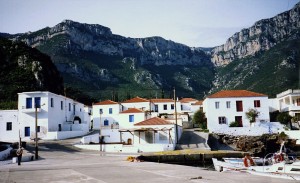
Kiparissi: The village looking down the jetty
There are several mooring options in this large bay. The obvious spot is on the jetty that was previously used by the ferries. You can go side to on either side or bows or stern to off the end.
There is another pier at the north end of the bay where you can go bows or stern to, or alongside if it’s quiet. It’s a bit of a walk in to the village from here however.
The other options are to anchor either off the beach, at the north end of the bay, or behind the headland in the south east corner.
In theory, between these options you have shelter from pretty much any direction. That does however assume that there’s no one else in the bay competing for the above spaces!
In reality, there’s often some swell in to the bay at the best of times, and if the winds are strong and have any element of east in them, you are best avoiding the place and returning when the conditions are better.
Continue reading → - Mooring: Korfos
The bay is fairly easy to find. Beware the large reef off Ak Trelli, a mile or so east of Korfos. The reef extends further than is immediately obvious, especially if the sea is a bit choppy.
The restaurateurs will hail you as you approach the village, usually waving their mooring lines in their hand, though as the season progresses, many of these get chopped by propellers so you may need to do a quick flypast to see whether you need your anchor or not.
For those that don’t want to commit to the two quayside restaurants, there is plenty of space to anchor, giving you the freedom to dine where you wish. The beach around the bay is a safe place for children to play and swim.
Continue reading → - Mooring: Monemvasia
The rock is, unsurprisingly, not hard to spot. There are three mooring options, on the north jetty, in the “marina” south of the fisherman’s harbour, or anchored just south of the causeway.
The “marina” was going to be the solution to the lack of mooring space and did briefly extend to providing a couple of pontoons, though space was so tight that I once took a 42 footer in and on finding no spaces discovered the only way out was to reverse. Alas, the pontoons disappeared and the phase two development never reached fruition. That was a few years back when money was easy, so with the current economic trials I suspect we can abandon hope of any further development for many years to come.
What’s left of the “marina” still offers the best option and you can go stern to the quay or alongside on the inside of the breakwater. Larger vessels may be able to go stern to the loading ramp outside the south east corner though plenty of anchor chain will be needed and it’s rather exposed, leaving you side on to any meltemi winds.
If these locations are full, head for the jetty north of the causeway and moor on the west side, side to or stern to as conditions dictate. For those that don’t like getting warps out, anchor south of the causeway though you’ll have to push in as it gets deep fairly quickly.
Continue reading → - Mooring: Nafplion
It’s usually a good sail up to Nafplion with the wind funnelling up the Argolic Gulf, though as the seaway narrows there can be a bit of a chop. Nafplion itself is hard to miss. Head in to the bay observing the port mark and keeping south of Bourtzi Fortress.
Generally yachts moor stern to on the main (south) quay in front of the town, though at quieter times, yachts may lie alongside. You can also go alongside the first part of the commercial (east) quay, at the end nearest the south quay.
Occasionally, large cruise ships visit and you may be directed by the port authorities to go alongside the stubby ferry jetty. There are large rubber protectors on the side of the quay so make sure you are well fendered to avoid black marks down your hull.
For those who prefer to anchor, or when the slop in the bay makes staying on the quay too uncomfortable, there is plenty of room to swing on the hook in the bay.
Continue reading → - Mooring: Perdika
As with most Greek harbours, local boats occupy most of the space on the inside of the breakwater and the two quays. The seaward side of the breakwater is unusable for all but very large yachts due to the depths, so most yachts end up on the seaward side of the two quays.
These berths are vulnerable to wash from passing ferries, despite the fact these pass so far out to sea they will usually be out of sight before the wash reaches the harbour. Keep your yacht well off the quay and ensure your anchor is well in. This means dropping the anchor right up beside the bows of the boats opposite.
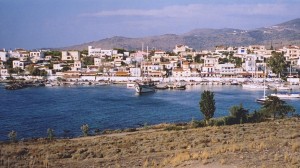
Perdika: The breakwater (left) and two quays, (centre and right)
If berthing on the seaward quay, watch out for underlying rocks at the quay edge. There is one spot near the end of the quay where these are particularly prominent yet nearly every day, someone comes in late, fails to wonder why in the busy harbour this spot has been left empty and smacks their rudder on the rocks! They’re really really easy to see – you just have to look!!
At busy times, you may want to consider going alongside the water tanker berth at the end of the seaward quay. You will however have to leave if the tanker comes and he sometimes comes very early in the morning. You could try asking the locals when the tanker is next expected but I’ve tried several times to establish movement times direct with the captain and even he didn’t seem to know when he was next likely to return!
Continue reading → - Mooring: Plaka / Leonidion
If you’re coming from the east, it can be hard to make out the harbour, especially as the sun lowers in the west. Look out for the flat topped mountain and head slightly south of that and eventually you will see a telephone mast high on top the hill, or the bright blue hotel.
If coming along the coast, the harbour is at the south end of the long beach so once you’ve found that, the rest is easy.The harbour entrance is plenty wide and boats normally berth stern or bows to. The quay is quite high so depending on the design of your boat, you may find it easier to get off if you go bows to.
At quieter times, boats sometime go side on, especially towards the inner end of the quay where there are underwater concrete blocks up against the quay. Watch for these if going in stern to.
The harbour is very deep in the centre, especially nearer the entrance, so you will need plenty of anchor. Holding is usually good once you’ve caught hold but it does sometime take a couple of tries to get the anchor to set.
Water is available on the quay – the waterman will sometimes come and ask if you need any. There is a port police office but it’s rare to see them on the quay.
More for interest than because it has any affect on your mooring (other than reducing the available space), I thought it was worth showing a couple of pictures of the damage caused by the severe storm in February 2012, when winds allegedly reached force 11. Don’t panic, that’s extremely unusual even for winter storms and the change of winds like that during your holiday are extremely unlikely to put it mildly.
Unfortunately, it took many years to acquire the EU funding to “improve” the harbour around 2004. I fear it will take many more before any cash appears to rebuild the damaged section of the quay.
Continue reading → - Mooring: Poros
Poros is separated from the mainland by a channel a few hundred metres across with a shallow area at the South East end. The town can therefore be approached from the east, keeping north of the rocks just west of fortress island of Nisos Bourtzi, or from the west. Generally, if you’ve been cruising south of Poros, you will arrive from the east, if you’ve been sailing to the north, you’ll arrive from the west.
The channel is busy with ferries and hydrofoils passing in both directions, small passenger ferries and larger car ferries shuttling between Poros and it’s mainland sister town of Galatas, and yachts arriving and leaving the quay. So keep a good lookout and don’t forget to look behind you as well as ahead. It can be daunting to see a ferry heading towards you but there is plenty of room for you to pass, provided you keep to the edge of the channel.
The channel follows the line of the quay, kinking north then south again. If you attempt to take a short cut across the southern half you will go aground. This is particularly tempting if you arrive from the east as you will see yachts on buoys opposite the charter base and many more further down, but between the two it is shallow. The bottom is soft so you will be unlucky to do any damage but the water taxis make good money towing people off – they don’t do it for free!
They seem to get at least one customer a day in high season, sometimes more. I watched two yachts in succession do it last June and even Flotilla lead yachts have been known to end up there! The chart is clear and if you haven’t bothered to check it I suggest you go slow so at least you have a chance of getting yourself off without assistance. Keeping your speed down in the channel is wise anyway – the locals get fed up with people tearing through putting up unnecessary wash.
If you’ve chartered from Poros, the company’s quay at the east end of the channel is available for your use but make sure there is a member of staff around to help you in – there’s a technique to dealing with the crosswinds and strong currents that sometimes come down the channel! Mooring here is on mooring lines.
If you’ve chartered from elsewhere, use the new pontoons and quay at the west end of town which have water and electricity available. There are a few mooring lines on the pontoons, though these seem to be disappearing at a rate of knots, certainly far faster than thy’re being repaired!
I would suggest you avoid going stern to on the south quay, between the charter base and the water ferry landing spot. Aside from the large swell put up by passing ferries, which will be with feet of your yachts and challenges the most well set anchor, the bottom is strewn with all sorts and fouled anchors are common. There’s nothing to get the adrenalin going like pirouetting around your stuck anchor mid channel as a ferry bears down on you!
There are a few spaces here where you can go side too (near the main square) but yachts usually raft out here so be prepared for company, and a lot of noise from the bars nearby. You will find it quieter on the quay and pontoons on the west side.
If you prefer anchoring, most of the bays are fine for daytime stops, with the bays west of the town offering better shelter if you’re staying overnight. In fact if you’re the type who has always worried about spending a night on the hook, these are excellent places to build your confidence, with virtually all around shelter and good holding. In high season you will need to take a line ashore as you’re unlikely to be alone.
- Mooring: Sambateki / Sabateki
The harbour is about half way between Tiros and Plaka. Coming from the east it will be hard to make out – head for the left edge of the flat topped mountain and you’ll be close. Lying immediately south of a headland, it’s easier to find if you’re heading up the coast but not visible until you round the headland if you’re headed south.
The new breakwater is a substantial boulder built affair. Moor stern or bows to on the inner side, towards the seaward end where it’s deeper – the inner end is usually full of fishing boats.
Like the new quay at Plaka, there are underwater blocks immediately in front of the quay so watch your rudder if going stern to.
Continue reading → - Mooring: Tiros
The bay is easily found, lying just north of Ak. Tiros which has three windmills on the top. The quay is at the south end of the bay, just north of the headland. Coming from the north it can be hard to make out the harbour but just keep heading south down the bay and it will appear.
Moor stern or bows to on the inside of the quay. You may roll around a bit just outside the quay but hold your nerve, it’s plenty deep until you get very close to the beach.
This is fortunate as the space behind the quay is not large and you will need to lay your anchor well over towards the beach. There are usually some buoys for small craft just off the beach and you should aim to get your anchor just seaward of these. The holding is actually good, it’s just the quay is rather close to the shore!
At busy times, there is room to go alongside at the end of the quay though it can be a bit uncomfortable here. The quay isn’t large and it only takes about a dozen yachts to fill it. Once full, there isn’t really room to raft out and it’s a bit deep and exposed to anchor so allow time to try somewhere else.
Continue reading → - Mooring: Vathi

Vathi: Fishing quay with harbour entrance behind
The harbour breakwater is easily spotted as you head south down the side of the Methana peninsula. Contrary to first appearances, the entrance is at the south end of the breakwater where there’s a white post, not at the north end. Keep to the middle of the entrance as it’s shallow at the sides. There’s not much room inside, so you may want to let anyone already in the process of mooring sort themselves out before you enter.
Moor on the south quay, dropping your anchor right across the other side of the harbour next to the fishing boats. A chap called Costas, often sporting a T shirt proclaiming his role as harbour master may direct you in to a spot. If mooring at the inner end of the quay, watch your rudder – it’s shallow close to the quay.
The shelter is excellent but with the limited space, crossed anchors are common so keep an eye on what’s happening when it comes to departure time. If you’re the yacht on the end of the quay near the harbour entrance you might also want to watch out as people enter as I have had my anchor hooked by boats entering the harbour.
Continue reading → - Mooring: Vivari / Khaidhari
The entrance to the bay is not easy to make out but you will eventually make out the ruins of a fort on the west side of the entrance. The small stub jetty is in the top north west corner of the bay but is often largely occupied by local boats. Even if it’s quiet, there’s only room for a couple of yachts.
However, if you don’t mind a dinghy trip ashore, there is loads of space to anchor.
The bay can occasionally suffer from late afternoon winds but the holding is good and the winds die down later.
Continue reading → - Mooring: Yerakas
Details coming soon but here’s a picture of this pretty village
Continue reading →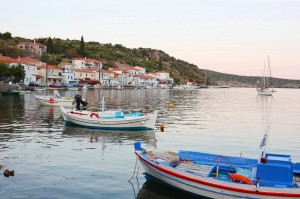
Yerakas: The quayside and village



